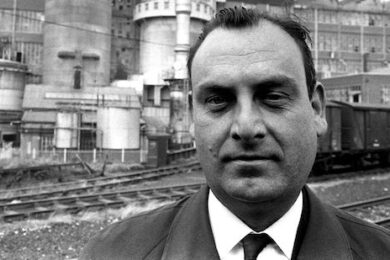Each time I watch No Two The Same some new oddity jumps out at me. On this occasion it’s Nairn’s skinny necktie. If Bo Diddley had a rattlesnake, then Nairn here has something that looks more like an eel, one valiantly trying to escape his stiff white collar and embark on its migration to the Sargasso Sea. No tie should look quite this errant and unruly, but there it is, cutting curious criss-cross shapes and tying itself in knots. The tie is all the more striking for the contrast it makes with Nairn’s bulky frame, and already rather puffy face. And then there is the discomfort with which, standing in the middle of the Lillington Estate, he’s posed: speaking directly to camera with a left arm he clearly doesn’t know what to do with. It’s tucked awkwardly behind his back, that side of the suit jacket dragged back with it, like a twitched curtain.
No Two The Same is a 1970 essay film by the architectural writer Ian Nairn about the area of Pimlico in London, produced by the Government funded Central Office of Information, a post-war successor to the wartime propaganda unit the Ministry of Information. Nairn’s biographers Gillian Darley and David McKie observed that ‘just to watch’ this film is filled with a kind of ‘deep’ embarrassment for all concerned and not least Nairn himself. And they are not wrong. His language is, as they say, "stilted and awkward" throughout and his attempts to interact with even a specially selected set of local residents makes for often excruciating viewing. And yet I am drawn back to it again and again as a fascinating social document and equally for what it seems, inadvertently or otherwise, to tell us about Nairn, especially in this of all years, the 40th anniversary of his death. It’s something I’ve been even more acutely aware of while writing the introduction to a new edition of Nairn’s Modern Buildings in London, a primer on the best of contemporary architecture in the capital that was first published by London Transport in 1964.
No Two The Same appeared six years later. It was fifteen years since Nairn had first come to public prominence with the authorship of ‘Outrage’, a polemical special issue of Architectural Journal published in June 1955. In it Nairn had coined the term ‘subtopia’ to describe what he saw as “the universal suburbanisation… of the whole land surface” with the end of Carlisle looking identical to the beginning of Southampton and vice versa, and everywhere bespoiled by needless junk (pointless signage, barbed-wire, concrete lamp posts et al.) A whole year before John Osborne’s Look Back In Anger hit the Royal Court, Nairn was feted by the press as the original angry young man. His incendiary views on the built environment, enthusiasm for the very best of modern architecture and utter contempt for the shoddy and the second-rate would go on to inspire the Anti-Ugly Action protest group, whose leading members included the tragically short-lived pop artist and actor Pauline Boty.
Nairn was to join The Observer newspaper, using its pages in 1966 to issue ‘Stop the Architects Now!’ a lengthy and impassioned screed against the then widespread and unthinking destruction of many historic townscapes in redevelopment schemes. That same year saw the publication of Nairn’s London, a brilliantly opinionated and deeply personal architectural survey of the capital that many rightly believe remains his masterpiece. Soon after this he was poached by The Sunday Times and approached by John Mapplebeck, a producer at the BBC working on the regional Look North strand, about making a documentary. Their opening salvo was the series Nairn’s North with the writer offering his views on the likes of Bradford, the River Mersey and the Pennines, which aired locally in 1967.
As Mapplebeck would later recall, Nairn was far from a natural TV performer. He insisted on working without a script, extemporising on the spot about whatever he encountered, something that inevitably led to hit and…



